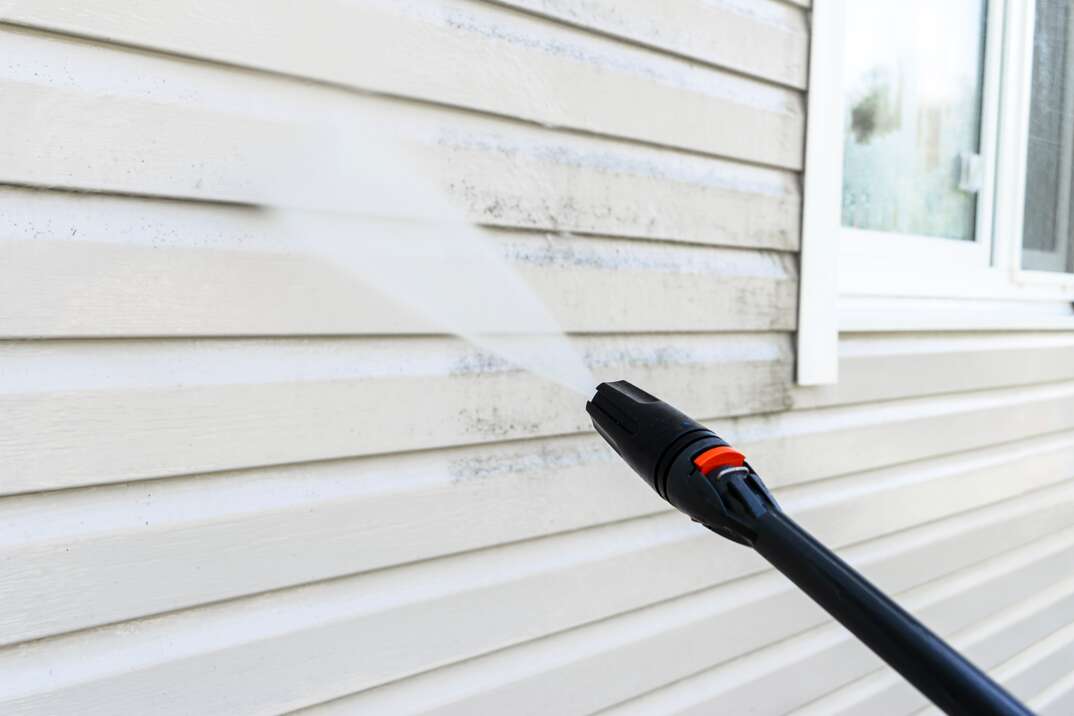How to Clean Vinyl Siding

Compared to other types of siding, vinyl is low maintenance, inexpensive and durable. Over time, however, it’ll get grimy from dirt, spider webs, pollen and all the other things nature has to offer.
This May Also Interest You: Deciding on Siding? Here’s How Much Siding Installation Costs
Freshening up your vinyl siding can up your curb appeal and can make the siding last longer. Here’s what to do — and what to avoid — to keep your siding in good shape.
What’s the Best Homemade Vinyl Siding Cleaner?
While you can use commercial cleaners, it's just as easy to make a homemade cleaning solution. Mix one part vinegar with two parts plain water for a simple, effective cleaning solution. It's good for general purpose cleaning as well as removing mold and mildew from the siding. Vinegar can damage or kill many types of plants, so use this solution with caution if you have landscaping along the side of your home.
If you are worried about your plants, you can also use gentle dishwashing soap and water as your cleaning solution. A little soap shouldn't hurt them. Another alternative is a cup of oxygen bleach — not chlorine bleach — mixed with a gallon of water. Oxygen bleach doesn't harm your plants.
What’s the Best Way to Clean Vinyl Siding?
The best way to clean vinyl siding is using old-fashioned elbow grease, plus a soft, lint-free cloth or a soft-bristled brush with a long handle. Dip the cleaning tool you choose in the cleaning solution, and scrub the vinyl siding one section at a time. Grab your garden hose to rinse the siding from the top of the house to the bottom to remove all of the cleaner and dirt.
Can You Pressure Wash Vinyl Siding?
A pressure washer is an easy option as a vinyl siding cleaner. The pressure of the water helps clean off dirt and debris without manual scrubbing. Check with the siding manufacturer; some recommend skipping the pressure washer. The manufacturer might also give recommendations for pressure settings and cleaners to use with the pressure washer. If you don't have access to manufacturer recommendations, a general-purpose cleaner for pressure washers is usually safe. Read the packaging to verify that it's safe for use on siding.
Start with a low-pressure setting to reduce the risk of damage to the siding. Point the sprayer straight ahead of you or at a slight downward angle. Never point it at an upward angle, as the water could make its way under the siding. Avoid using a pressure washer near openings or gaps in the siding for the same reason. This includes areas around windows, doors and plumbing. Keep the pressure washer nozzle moving to avoid damaging the siding.
Cleaning Products to Avoid
Even though vinyl siding is durable, it can become damaged with certain products and cleaning tools. Steel wool, stiff-bristled scrub brushes, sponges with abrasive surfaces and similar cleaning tools can damage the siding. Cleaners to avoid include undiluted chlorine bleach, liquid degreasers, nail polish remover and any other harsh chemicals. If you're not sure whether a cleaner will damage your siding, test it on a small, hidden area first.
More Related Articles:
- How Much Does It Cost to Paint a House?
- How Much Does It Cost to Stucco a House?
- How to Install Stucco Siding
- How Much Does Cedar Shake and Shingle Siding Cost?
- Hardie Board: When Vinyl Siding Just Won’t Do
How to Clean Vinyl Siding Safely
When deciding how to clean vinyl siding, don't forget about safety. You’ll probably need a ladder to reach the top portions of siding. Position the ladder securely on flat ground, ensuring that it's stable before climbing it. Move the ladder frequently instead of leaning to the side to reach other areas.
If you use any chemical cleaners on your siding, wear protective gear. Long sleeves, pants and gloves keep the chemicals off your skin. Goggles help protect your eyes from splashing chemicals as you clean the siding.
To help protect your landscaping, wet down the plants and the ground before you start cleaning your siding. This can reduce the chance of the plants absorbing the cleaner. If you're using chemicals or cleaning ingredients that might harm them, you can cover the plants with plastic to protect them from splashes. Uncover them as soon as possible, especially in hot weather, as the plastic can trap heat and damage them.
Avoid mixing different types of cleaners together. Bleach can be dangerous when you mix it with certain other ingredients, including ammonia and vinegar. It's safest to use one type of cleaner instead of mixing to prevent dangerous reactions.
Inspect Your Siding
Once you've figured out how to clean vinyl siding and done the job well, you can inspect the siding to make sure it's in good shape. This is a good opportunity to look for dents, loose siding and other damage. It might be time to replace your siding if you notice fading, peeling or bubbling.
Since we’re all home now more than ever, being prepared for unexpected home repairs with a plan from HomeServe is important. Having a plan in place gives you peace of mind knowing that you can simply call our 24/7 repair hotline for covered breakdowns. See what plans are available in your neighborhood.


